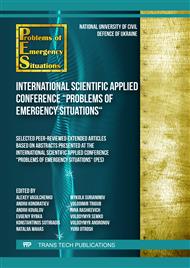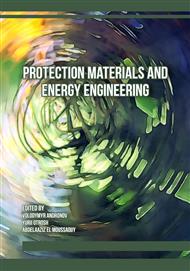[1]
S. Semichaevsky, M. Yakimenko, M. Osadchuk, Regarding emergency spillage of flammable liquids, Vcheni zapysky TNU V.Vernadsʹkoho. Tekhnichni nauky, 32(71-3) (2021) 219–225.
DOI: 10.32838/2663-5941/2021.3/33
Google Scholar
[2]
Y. Abramov, O. Basmanov, J. Salamov, A. Mikhayluk, O. Yashchenko, Developing a model of tank cooling by water jets from hydraulic monitors under conditions of fire, Eastern-European Journal of Enterprise Technologies, 1/10(97) (2019) 14–20.
DOI: 10.15587/1729-4061.2019.154669
Google Scholar
[3]
A. Levterov, Acoustic Research Method for Burning Flammable Substances, Acoustical Physics, 65(4) (2019) 444–449.
DOI: 10.1134/s1063771019040109
Google Scholar
[4]
R. Saravanan, T. Karunanithi, L. Govindarajan, A Risk Assessment Methodology for Toxic Chemicals Evaporation from Circular Pools, J. Appl. Sci. Environ. Manage, 1 (2007) 91–100.
DOI: 10.4314/jasem.v11i1.46841
Google Scholar
[5]
Y. Abramov, O. Basmanov, J. Salamov, A. Mikhayluk, Model of thermal effect of fire within a dike on the oil tank, Naukovyi Visnyk Natsionalnoho Hirnychoho Universytetu, 2 (2018) 95–100.
DOI: 10.29202/nvngu/2018-2/12
Google Scholar
[6]
O. Popov, D. Taraduda, V. Sobyna, D. Sokolov, M. Dement, A. Iatsyshyn, V. Kovach, V. Artemchuk, D. Taraduda, T. Yatsyshyn, I. Matvieieva, Analysis of possible causes of NPP emergencies to minimize risk of their occurrence, Nuclear and Radiation Safety, 1(81) (2019) 75–80.
DOI: 10.32918/nrs.2019.1(81).13
Google Scholar
[7]
O. Popov, A. Iatsyshyn, V. Kovach, V. Artemchuk, D. Taraduda, V. Sobyna, D. Sokolov, M. Dement, V. Hurkovskyi, K. Nikolaiev, T. Yatsyshyn, D. Dimitriieva, Physical features of pollutants spread in the air during the emergency at NPPs, Nuclear and Radiation Safety,4(84) (2019) 88–98.
DOI: 10.32918/nrs.2019.4(84).11
Google Scholar
[8]
A. Teslenko, A. Chernukha, O. Bezuglov, O. Bogatov, E. Kunitsa, V. Kalyna, A. Katunin, V. Kobzin, S. Minka, Construction of an algorithm for building regions of questionable decisions for devices containing gases in a linear multidimensional space of hazardous factors, Eastern-European Journal of Enterprise Technologies, 5/10(101) (2019) 42–49.
DOI: 10.15587/1729-4061.2019.181668
Google Scholar
[9]
B. Pospelov, V. Andronov, E. Rybka, Development of The Method of Operational Forecasting of Fire in the Premises of Objects Under Real Conditions, Eastern-European Journal of Enterprise Technologies, 2 (2021) 43–50.
DOI: 10.15587/1729-4061.2021.226692
Google Scholar
[10]
I. F. Dadashov, V. M. Loboichenko, V. M. Strelets, M. А. Gurbanova, F. M. Hajizadeh, A. І. Morozov, About the environmental characteristics of fire extinguishing substances used in extinguishing oil and petroleum products [Neft və neft məhsullarının söndürülməsində tətbiq olunan yanğınsöndürücü vasitələrin ekoloji xüsusiyyətlərinin təhlili], SOCAR Proceedings, 5 (2020) 79–84.
DOI: 10.5510/ogp20200100426
Google Scholar
[11]
D. Trehubov, O. Tarakhno, Rozbavlennya paropovitryanoho prostoru paroyu nehoryuchoho komponentu. Problemy pozharnoy bezopasnosty, 33 (2013) 183–187[in Ukrainian].
Google Scholar
[12]
V. Balanyuk, N. Kozyar, O. Garasymuyk, Study of fire-extinguishing efficiency of environmentally friendly binary aerosol-nitrogen mixtures, Eastern-European journal of enterprise technologies, Technical science, 3/10(71) (2016) 4–12.
DOI: 10.15587/1729-4061.2016.72399
Google Scholar
[13]
A. Chernukha, A. Teslenko, P. Kovaliov, O. Bezuglov, Mathematical modeling of fire-proof efficiency of coatings based on silicate composition, Materials Science Forum, 1006 (2020) 70–75.
DOI: 10.4028/www.scientific.net/msf.1006.70
Google Scholar
[14]
D. Dubinin, K. Korytchenko, A. Lisnyak, I. Hrytsyna, V. Trigub, Improving the installation for fire extinguishing with finelydispersed water, Eastern-European Journal of Enterprise Technologies, 2(10–92) (2018) 38–43.
DOI: 10.15587/1729-4061.2018.127865
Google Scholar
[15]
K. Korytchenko, O. Sakun, D. Dubinin, Y. Khilko, E. Slepuzhnikov, A. Nikorchuk, I. Tsebriuk, Experimental investigation of the fire-extinguishing system with a gas-detonation charge for fluid acceleration, Eastern-European Journal of Enterprise Technologies, 3/5(93) (2018) 47–54.
DOI: 10.15587/1729-4061.2018.134193
Google Scholar
[16]
S. Vambol, V. Vambol, I. Bogdanov, Y. Suchikova, N. Rashkevich, Research of the influence of decomposition of wastes of polymers with nano inclusions on the atmosphere, Eastern-European Journal of Enterprise Technologies, 6/10(90) (2017) 57–64.
DOI: 10.15587/1729-4061.2017.118213
Google Scholar
[17]
S. Ragimov, V. Sobyna, S. Vambol, V. Vambol, A. Feshchenko, A. Zakora, E. Strejekurov, V. Shalomov, Physical modelling of changes in the energy impact on a worker taking into account high-temperature radiation, Journal of Achievements in Materials and Manufacturing Engineering, 91(1) (2018) 27–33.
DOI: 10.5604/01.3001.0012.9654
Google Scholar
[18]
V. Andronov, B. Pospelov, E. Rybka, Development of a method to improve the performance speed of maximal fire detectors, Eastern-European Journal of Enterprise Technologies, 2/9(86) (2017) 32–37.
DOI: 10.15587/1729-4061.2017.96694
Google Scholar
[19]
I. Dadashov, V. Loboichenko, V. Strelets, M. Gurbanova, A. Morozov, F. Hajizadeh, About the environmental characteristics of fire extinguishing substances used in extinguishing oil and petroleum products, SOCAR Proceedings, 5 (2020) 79-84.
DOI: 10.5510/ogp20200100426
Google Scholar
[20]
A. Kireev, D. Tregubov, S. Safronov, D. Saveliev, Study Insulating and Cooling Properties of the Material on the Basis of Crushed Foam Glass and Determination of its Extinguishing Characteristics with the Attitude to Alcohols, Materials Science Forum, 1006 (2020) 62–69.
DOI: 10.4028/www.scientific.net/msf.1006.62
Google Scholar
[21]
V. Borovykov, Hasinnya pozhezh u rezervuarakh dlya zberihannya nafty ta naftoproduktiv, Pozhezhna ta tekhnohenna bezpeka, 11(26) (2015) 28–29 [in Ukrainian].
Google Scholar
[22]
I. Glassman, R. Yetter, Combustion, London, Elsevier, 2014.
Google Scholar
[23]
R. Korolov, V. Kovalyshyn, В.Shtajn, Analysis of methods for extinguishing fires in reservoirs with oil products by a combined method, ScienceRise, 6(35) (2017) 41–50.
DOI: 10.15587/2313-8416.2017.104613
Google Scholar
[24]
R. Pietukhov, A. Kireev, D. Tregubov, S. Hovalenkov, Experimental Study of the Insulating Properties of a Lightweight Material Based on Fast-Hardening Highly Resistant Foams in Relation to Vapors of Toxic Organic Fluids, Materials Science Forum, 1038 (2021) 374–382.
DOI: 10.4028/www.scientific.net/msf.1038.374
Google Scholar
[25]
Un procedimiento para la preparacion de un gel de poliacrilatosodico. Pat. ES 8901936: A62C 5/033, C09K 21/14, 2 018 370; Fecha de presentacion: 02.06.89; Рublicacion de patente: 01.04.91.
Google Scholar
[26]
I. Dadashov, A. Kireev, I. Kirichenko, A. Kovalev, A. Sharshanov, Simulation of the insulating properties of two-layer material, Functional materials, 25(4) (2018) 774–779.
DOI: 10.15407/fm25.04.774
Google Scholar
[27]
J. H. Eom, Y. W. Kim, S. Raju, Processing and properties of macroporous silicon carbide ceramics. Journal of Asian Ceramic Societies, 1(3) (2013) 220–242.
DOI: 10.1016/j.jascer.2013.07.003
Google Scholar
[28]
A. Kireev, I. Kirichenko, R. Petukhov, A. Sharshanov, T. Yarkho, Modeling the insulating properties of multicomponent solid foam-like material based on gel-forming systems, Functional materials, 28(3) (2021) 549–555.
DOI: 10.15407/fm28.03.549
Google Scholar
[29]
I. Dadashov, V. Loboichenko, A. Kireev, Analysis of the ecological characteristics of environment friendly fire fighting chemicals used in extinguishing oil products, Pollution Research, 37 (2018) 63–77.
Google Scholar
[30]
R. Bubbico, B. Mazzarotta, Predicting Evaporation Rates from Pools, Chemical engineering transactions, 48 (2016) 49–54.
Google Scholar
[31]
D. Tregubov, O. Tarakhno, V. Deineka, F. Trehubova, Oscillation and Stepwise of Hydrocarbon Melting Temperatures as a Marker of their Cluster Structure, Solid State Phenomena, 334 (2022) 124–130.
DOI: 10.4028/p-3751s3
Google Scholar
[32]
D. Trehubov, A. Sharshanov, D. Sokolov, F. Trehubova, Forecasting the smallest supermolecular formations for alkanes of normal and isomeric structure, Problems of Emergency Situations, 35 (2022) 63–75.
Google Scholar
[33]
C. Alba-Simionesco, G. Dosseh, E. Dumont, B. Frick, B. Geil, D. Morineau, V. Teboul, Y. Xia, Confinement of molecular liquids: Consequences on thermodynamic, static and dynamical properties of benzene and toluene, The European physical journal. E. Soft matter, 12 (2003) 19–28.
DOI: 10.1140/epje/i2003-10055-1
Google Scholar
[34]
Pub Chem. Compound summary. Information on https://pubchem.ncbi.nlm.nih.gov/.
Google Scholar
[35]
I. Yu. Doroshenko, Spectroscopic study of cluster structure of n-hexanol trapped in an argon matrix, Low Temperature Physics, 3(6) (2017) 919–926.
DOI: 10.1063/1.4985983
Google Scholar



